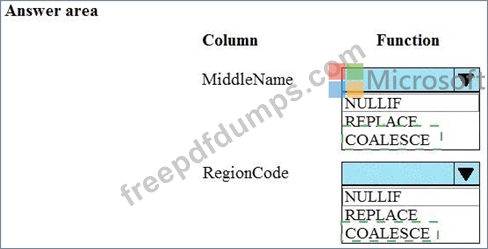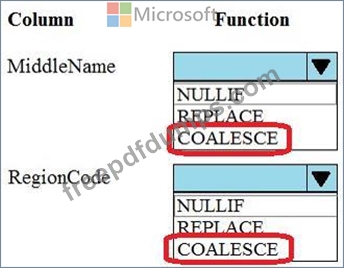070-761 Exam Question 76
Note: This question is part of a series of questions that use the same scenario. For your convenience, the scenario is repeated in each question. Each question presents a different goal and answer choices, but the text of the scenario is exactly the same in each question in this series.
Start of repeated scenario
You have a database that contains the tables shown in the exhibit. (Click the Exhibit button.)
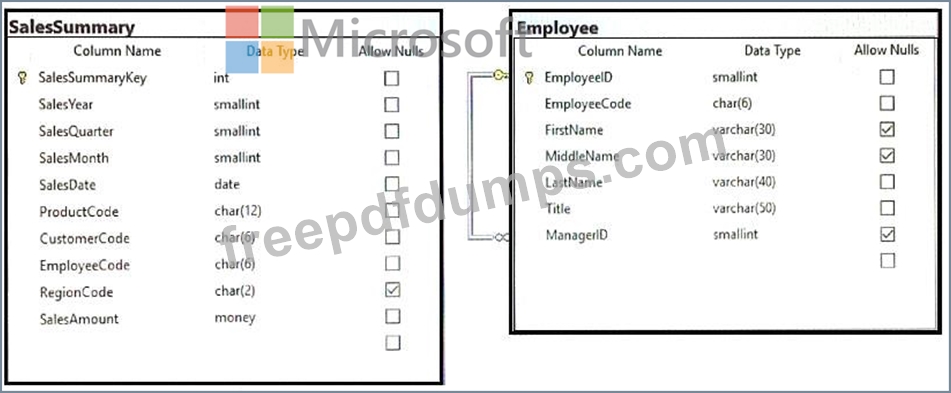
You review the Employee table and make the following observations:
- Every record has a value in the ManagerID except for the Chief Executive Officer (CEO).
- The FirstName and MiddleName columns contain null values for some records.
- The valid values for the Title column are Sales Representative manager, and CEO.
You review the SalesSummary table and make the following observations:
- The ProductCode column contains two parts: The first five digits represent a product code, and the last seven digits represent the unit price. The unit price uses the following pattern: ####.##.
- You observe that for many records, the unit price portion of the ProductCode column contains values.
- The RegionCode column contains NULL for some records.
- Sales data is only recorded for sales representatives.
You are developing a series of reports and procedures to support the business. Details for each report or procedure follow.
Sales Summary report: This report aggregates data by year and quarter. The report must resemble the following table.

Sales Manager report: This report lists each sales manager and the total sales amount for all employees that report to the sales manager.
Sales by Region report: This report lists the total sales amount by employee and by region. The report must include the following columns: EmployeeCode, MiddleName, LastName, RegionCode, and SalesAmount. If MiddleName is NULL, FirstName must be displayed. If both FirstName and MiddleName have null values, the world Unknown must be displayed/ If RegionCode is NULL, the word Unknown must be displayed.
Report1: This report joins data from SalesSummary with the Employee table and other tables. You plan to create an object to support Report1. The object has the following requirements:
- be joinable with the SELECT statement that supplies data for the report
- can be used multiple times with the SELECT statement for the report
- be usable only with the SELECT statement for the report
- not be saved as a permanent object
Report2: This report joins data from SalesSummary with the Employee table and other tables.
You plan to create an object to support Report1. The object has the following requirements:
Sales Hierarchy report. This report aggregates rows, creates subtotal rows, and super-aggregates rows over the SalesAmount column in a single result-set. The report uses SaleYear, SaleQuarter, and SaleMonth as a hierarchy. The result set must not contain a grand total or cross-tabulation aggregate rows.
Current Price Stored Procedure: This stored procedure must return the unit price for a product when a product code is supplied. The unit price must include a dollar sign at the beginning. In addition, the unit price must contain a comma every three digits to the left of the decimal point, and must display two digits to the left of the decimal point. The stored procedure must not throw errors, even if the product code contains invalid data.
End of Repeated Scenario
You need to create the query for the Sales by Region report.
Which function should you apply to each column? To answer, select the appropriate options in the answer area.
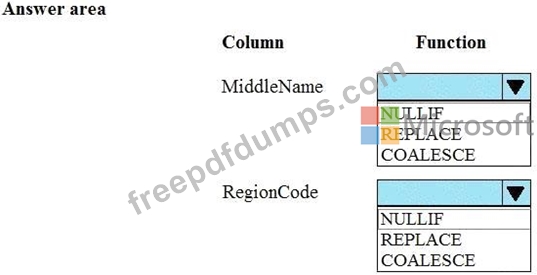
Start of repeated scenario
You have a database that contains the tables shown in the exhibit. (Click the Exhibit button.)

You review the Employee table and make the following observations:
- Every record has a value in the ManagerID except for the Chief Executive Officer (CEO).
- The FirstName and MiddleName columns contain null values for some records.
- The valid values for the Title column are Sales Representative manager, and CEO.
You review the SalesSummary table and make the following observations:
- The ProductCode column contains two parts: The first five digits represent a product code, and the last seven digits represent the unit price. The unit price uses the following pattern: ####.##.
- You observe that for many records, the unit price portion of the ProductCode column contains values.
- The RegionCode column contains NULL for some records.
- Sales data is only recorded for sales representatives.
You are developing a series of reports and procedures to support the business. Details for each report or procedure follow.
Sales Summary report: This report aggregates data by year and quarter. The report must resemble the following table.

Sales Manager report: This report lists each sales manager and the total sales amount for all employees that report to the sales manager.
Sales by Region report: This report lists the total sales amount by employee and by region. The report must include the following columns: EmployeeCode, MiddleName, LastName, RegionCode, and SalesAmount. If MiddleName is NULL, FirstName must be displayed. If both FirstName and MiddleName have null values, the world Unknown must be displayed/ If RegionCode is NULL, the word Unknown must be displayed.
Report1: This report joins data from SalesSummary with the Employee table and other tables. You plan to create an object to support Report1. The object has the following requirements:
- be joinable with the SELECT statement that supplies data for the report
- can be used multiple times with the SELECT statement for the report
- be usable only with the SELECT statement for the report
- not be saved as a permanent object
Report2: This report joins data from SalesSummary with the Employee table and other tables.
You plan to create an object to support Report1. The object has the following requirements:
Sales Hierarchy report. This report aggregates rows, creates subtotal rows, and super-aggregates rows over the SalesAmount column in a single result-set. The report uses SaleYear, SaleQuarter, and SaleMonth as a hierarchy. The result set must not contain a grand total or cross-tabulation aggregate rows.
Current Price Stored Procedure: This stored procedure must return the unit price for a product when a product code is supplied. The unit price must include a dollar sign at the beginning. In addition, the unit price must contain a comma every three digits to the left of the decimal point, and must display two digits to the left of the decimal point. The stored procedure must not throw errors, even if the product code contains invalid data.
End of Repeated Scenario
You need to create the query for the Sales by Region report.
Which function should you apply to each column? To answer, select the appropriate options in the answer area.

070-761 Exam Question 77
Note: This question is part of a series of questions that present the same scenario. Each question in the series contains a unique solution that might meet the stated goals. Some question sets might have more than one correct solution, while others might not have a correct solution.
After you answer a question in this section. You will NOT be able to return to it. As a result, these questions will not appear in the review screen.
You have a table that was created by running the following Transact-SQL statement:

The Products table includes the data shown in the following table:

TotalUnitPrice is calculated by using the following formula:
TotalUnitPrice = UnitPrice * (UnitsInStock + UnitsOnOrder)
You need to ensure that the value returned for TotalUnitPrice for ProductB is equal to 600.00.
Solution: You run the following Transact-SQL statement:

Does the solution meet the goal?
After you answer a question in this section. You will NOT be able to return to it. As a result, these questions will not appear in the review screen.
You have a table that was created by running the following Transact-SQL statement:

The Products table includes the data shown in the following table:

TotalUnitPrice is calculated by using the following formula:
TotalUnitPrice = UnitPrice * (UnitsInStock + UnitsOnOrder)
You need to ensure that the value returned for TotalUnitPrice for ProductB is equal to 600.00.
Solution: You run the following Transact-SQL statement:

Does the solution meet the goal?
070-761 Exam Question 78
Note: This question is part of a series of questions that present the same scenario. Each question in the series contains a unique solution that might meet the stated goals. Some question sets might have more than one correct solution, while others might not have a correct solution.
After you answer a question in this section, you will NOT be able to return to it. As a result, these questions will not appear in the review screen.
You are creating indexes in a data warehouse.
You have a dimension table named Table1 that has 10,000 rows. The rows are used to generate several reports.
The reports join a column that is the primary key.
The execution plan contains bookmark lookups for Table1.
You discover that the reports run slower than expected.
You need to reduce the amount of time it takes to run the reports.
Solution: You create a nonclustered index on the primary key column that includes the bookmark lookup columns.
Does this meet the goal?
After you answer a question in this section, you will NOT be able to return to it. As a result, these questions will not appear in the review screen.
You are creating indexes in a data warehouse.
You have a dimension table named Table1 that has 10,000 rows. The rows are used to generate several reports.
The reports join a column that is the primary key.
The execution plan contains bookmark lookups for Table1.
You discover that the reports run slower than expected.
You need to reduce the amount of time it takes to run the reports.
Solution: You create a nonclustered index on the primary key column that includes the bookmark lookup columns.
Does this meet the goal?
070-761 Exam Question 79
Note: This question is part of a series of questions that present the same scenario. Each question in the series contains a unique solution that might meet the stated goals. Some question sets might have more than one correct solution, while others might not have a correct solution.
After you answer a question in this section. You will NOT be able to return to it. As a result, these questions will not appear in the review screen.
You have a database that includes the tables shown in the exhibit (Click the Exhibit button.)
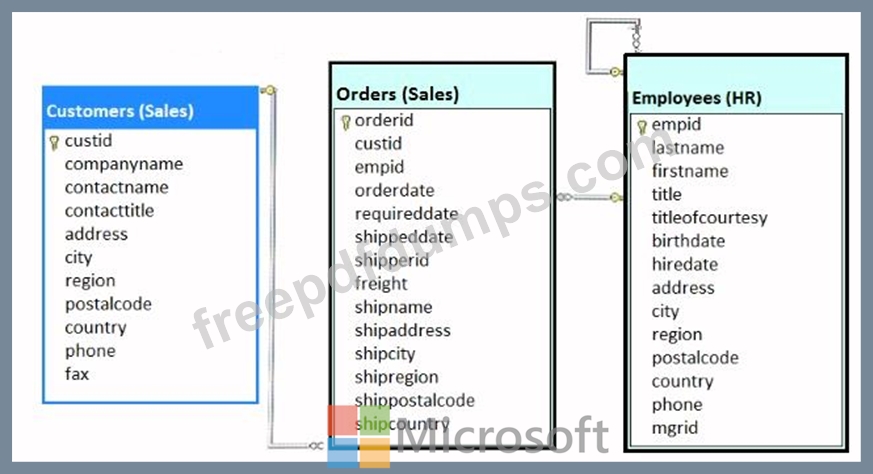
You need to create a Transact-SQL query that returns the following information:
-the customer number
-the customer contact name
-the date the order was placed, with a name of DateofOrder
-a column named Salesperson, formatted with the employee first name, a space, and the employee last name
-orders for customers where the employee identifier equals 4
The output must be sorted by order date, with the newest orders first.
The solution must return only the most recent order for each customer.
Solution: You run the following Transact-SQL statement:

Does the solution meet the goal?
After you answer a question in this section. You will NOT be able to return to it. As a result, these questions will not appear in the review screen.
You have a database that includes the tables shown in the exhibit (Click the Exhibit button.)

You need to create a Transact-SQL query that returns the following information:
-the customer number
-the customer contact name
-the date the order was placed, with a name of DateofOrder
-a column named Salesperson, formatted with the employee first name, a space, and the employee last name
-orders for customers where the employee identifier equals 4
The output must be sorted by order date, with the newest orders first.
The solution must return only the most recent order for each customer.
Solution: You run the following Transact-SQL statement:

Does the solution meet the goal?
070-761 Exam Question 80
You run the following Transact-SQL statement:

You use the table to store data about training courses: when they finished the location, and the number of participants in the courses.
You need to display a result set that shows aggregates for all possible combinations of the number of participants.
Which Transact-SQL statement should you run?
SELECT CourseID, CourseDate, SUM(NumParticipants)

You use the table to store data about training courses: when they finished the location, and the number of participants in the courses.
You need to display a result set that shows aggregates for all possible combinations of the number of participants.
Which Transact-SQL statement should you run?
SELECT CourseID, CourseDate, SUM(NumParticipants)


